INTRODUCTION
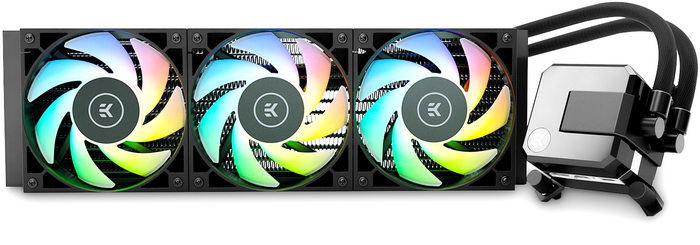
Size (total surface) has always been the quintessential factor when it comes to cooling and that has been equally true in the PC cooling "arena" both in regards to air and liquid coolers. So, whenever any manufacturer wanted (or needed) to boost the cooling efficiency of their products the solution was simple, increase the total aluminum and/or copper surface area to improve heat dissipation. Still due to interior case space constraints and increased costs such solutions may not have always be possible and so manufacturers needed another way to achieve the same (or almost the same) cooling results. That way turned out to be none other than the well-known push & pull configuration which required two fans (one at the front and one at the rear of the cooler and/or radiator) instead of one. For good or bad even though we've seen this with numerous air coolers in the past only a handful of AIO models have made their debut in the market with it as a feature the last of which is the AIO Elite D-RGB models EK Waterblocks released late last year.
EK® Water Blocks, the premium liquid cooling manufacturer, bears the name of its founder Edvard König. It all started with the enthusiasm of one man and his ventures with liquid cooling back in 1999. From its humble beginnings more than ten years ago, the company steadily grew to become the most renowned supplier of high-end premium quality liquid cooling products. Over the years, the company expanded its product portfolio to become a full liquid cooling solution provider know as EK. Today, EK products are available in more than 30 countries worldwide, and the company holds several partnerships with some of the most recognized brands.
The latest EK AIO Elite 360 D-RGB which i have here with me today is actually similar to the EK AIO 360 D-RGB i reviewed a while back (review here) since once again it's based on 395mm long and 27mm thick aluminum radiator and two 400mm long flexible nylon braided sleeved tubings. This however is where their similarities end since the EK AIO Elite 360 D-RGB is shipped with 6 instead of 3 EK-VARDAR S 120ER D-RGB 120mm PWM high static pressure fans (2200RPM/66.04CFM/2.89mmH2O/36.4dBA) and a high-performance ceramic-bearing pump (3300RPM instead of 2600RPM) with a coldplate made out of pure copper placed inside a black nickel metal housing (instead of acrylic). Yes, this does mean that the pump/waterblock combo lacks the somewhat unique addressable RGB illumination of the "regular" model but EK has placed an A-RGB LED right beneath their logo located on top which combined with the 6 EK-VARDAR S 120ER D-RGB fans (9 addressable RGB LEDs for each) produces an eye catching result (these of course are compatible with all the major motherboard ARGB/RGB sync technologies like ASUS Aura Sync, GB RGB Fusion, MSI Mystic Light and ASRock RGB LED). So, with a total of 3 more fans and a faster pump the EK AIO Elite 360 D-RGB should easily outperform the EK AIO 360 D-RGB, the question is by how much and that's what I'll try my best to answer in this review.
SPECIFICATIONS AND FEATURES

PACKAGING AND CONTENTS
Just like with past products by EK Water Blocks the front of the box is taken by a large product picture placed just over the Intel, AMD and RGB logos.
The main features list is also printed on the left side in 8 languages.
Printed at the base are the technical specifications, bundle contents and socket compatibility in 6 languages.
Turning the box around we find the main product features showcased by three pictures alongside three product drawings showcasing its size.
Packing is excellent with pieces of black foam placed around the product.
Along with the main body of the EK AIO Elite 360 D-RGB inside the box you will also find the six EK-VARDAR S 120ER fans, EK-hub, Y fan and RGB splitter, small thermal paste tube, fan and radiator mounting screws, backplate, installation instructions and all the required bits and pieces to mount the cooler onto Intel LGA1150/1151/1155/1156/1200/2011/2011-3/2066 and AMD AM4 compatible mainboards.
THE EK AIO ELITE 360 D-RGB
The main body of the EK AIO Elite 360 D-RGB is nearly identical with that of the 360 model (the pump/waterblock housing is the sole difference really).
Again, EK Water Blocks has used an 27mm thick aluminum radiator which surprisingly enough this time however has an FPI count (fins per inch) of 19.
A fill/drain port can again be found at the top of the radiator (typically accessing it voids the warranty).
For their 360 models EK Water Blocks has used 400mm long black sleeved low permeability tubes.

 EK Water Blocks has placed their logo on top of the black nickel pump cover (which is much thicker and premium looking than the one used with the tri-fan model).
EK Water Blocks has placed their logo on top of the black nickel pump cover (which is much thicker and premium looking than the one used with the tri-fan model).
As with most AIO models in the market today both tubes can rotate to make installation easier.

 The pure copper coldplate comes ready with a thin pre-applied layer of thermal conductive material on it (since I never use the bundled thermal pastes, obviously it was removed).
The pure copper coldplate comes ready with a thin pre-applied layer of thermal conductive material on it (since I never use the bundled thermal pastes, obviously it was removed).
Here you can see an exposed model of the pump (marketing material).
Each of the six bundled EK VARDAR S 120ER RGB fans can spin up to 2200RPM to produce up to 66.04CFM of airflow and 2.89 mmH2O of air-pressure with just 36.4dBA of noise.
Unfortunately, these fans still don’t have anti-vibration pads on their corners.
With all 6 fans mounted the thickness of the radiator jumps from 27mm to just under 80mm.
Last but not least the EK-Hub can accommodate up to 7 A-RGB fans (6 plus the pump really) so you don’t have to worry about available motherboard fan connectors and/or A-RGB splitter cables.
FINISHED LOOKS
My CPU cooling test rig may not support RGB/A-RGB (and where it’s placed taking pictures is hard) but as it so happened, I was building a new Z490 based test rig I decided to showcase the EK AIO Elite 360 D-RGB with that instead (all tests were done with the X79 test rig however).
First step (before or after you mount the radiator to your case) is to attach the corresponding brackets onto the base of the EK AIO Elite 360 D-RGB as seen above.
Then you just need to put the backplate behind the motherboard, mount the 4 mounting thumb screws and secure them with the 4 thumb nuts.
Now the good thing about the EK-Hub is that it has 2.5” mounting holes underneath so you can basically mount it on any 2.5” as seen above.
And voila, this is how the EK AIO Elite 360 D-RGB looks like when in operation (the system was still not complete at the time of this review but didn’t have to be to showcase this AIO).
Yes, the top of the pump is less impressive than the acrylic one used with the EK AIO 360 D-RGB but for some people this may actually be a better result (it is for me).
TEST BED
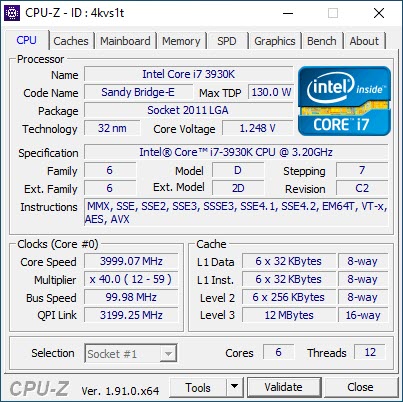

TESTING METHODOLOGY
Testing complete water cooling kits or individual radiators is no different than testing CPU Coolers and since we want all of you to be able to compare similar products, we created new and separate charts (you can still cross-compare results however since we are using the same test rig). So once again single (120/140mm) watercooling solutions are tested with the radiator mounted at the rear of our test rig while dual/triple/quad (240/260/280/360/420/480/560mm) solutions with the radiator mounted at the top. For the dBA tests complete water cooling kits or radiators with bundled fans are measured both while on idle mode or with the fan controller in the minimum setting and while on extreme load or with the fan controller all the way to the highest possible setting (PWM fans do that on their own without our intervention). Every single test takes place in a temperature controlled room of 23 degrees Celsius Ambient Temp with the help of two AC units placed diagonally inside the room. Finally, much like when testing CPU Coolers, it's very important to point out that just because a water cooling kit outperforms another when tested with our test rig (when we test complete water cooling kits) that does not necessarily mean that the same performance differences will apply 100% for other CPU models and in other situations (such as different ambient temps and system configurations).
To successfully record the load temperatures, we use the latest OCCT application for around 6-10 minutes to push the processor to its limits and after that is done and the temperatures are recorded, we wait for about 10-20 minutes for the CPU to cool down and record the idle temperatures. This is done to allow time for the thermal conductive material to achieve the optimal performance level. Same procedure is then repeated with the Passmark BurnIn Test as a failsafe just in case the OCCT results are wrong. This procedure takes a lot more time than the usual peltier/thermometer tests but this way not only can we deliver real world results to our readers based on real CPUs but we can also triple check the results using a variety of programs. Last but not least the temperatures were recorded using both the latest versions of AIDA64 and RealTemp while the noise level tests (when fans exist in the bundle) are performed using a high precision ExTech HD600 Decibel Meter placed about 10-15cm above the radiator. Still although the same testing procedure applies to all units do take into consideration that unlike the official numbers which are measured in special noise isolated labs with just the fans here, we also have both the rest of the cooler and the rest of the system (although all system fans are turned off when recording noise levels).
TEST RESULTS


CONCLUSION
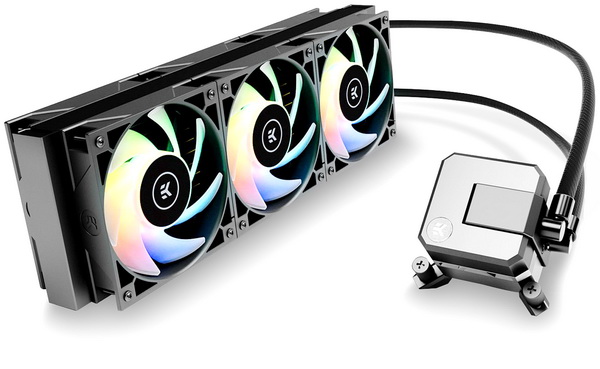
The EK AIO 360 D-RGB already outperforms many other similar AIO models so to further improve its performance EK had two possible routes, either use a thicker radiator or use 3 more fans in push & pull configuration. Using a thicker radiator would obviously result in higher end cost for consumers (EK would have to make a whole new factory line for that model) so adding 3 fans from a line they’ve been using for quite a while now seemed like the best choice. Equipping this model with a higher RPM pump certainly helped but not nearly as much as the 3 extra fans which as expected add to the overall noise levels of the EK AIO Elite 360 D-RGB. As a matter of fact, the EK AIO Elite 360 D-RGB is the 4th loudest AIO in my charts at full load (out of 66 tested models) so do keep that in mind if you plan on having the tower/case close to you. You also need to keep in mind the thickness of this particular model since at almost 80mm it’s not something that can be used with every case out there (the Meshify 2 XL by Fractal Design showcased in this review is a very spacious tower). As for looks well pictures tend to do all the talking so i don’t think anyone will have a problem in that regard (and the EK-Hub does help simplify installation).
With a retail price tag set at USD199.99 inside the USA (Amazon.com) and for 208.30Euros inside the EU (directly from EK) the EK AIO Elite 360 D-RGB AIO by EK Water Blocks may not be exactly what I’d call affordable but it’s priced better than many similar models. Yes if you don’t care about RGB lighting and your case has enough room for it the ARCTIC Liquid Freezer II 420 represents a much better price/performance ratio but for people who do care about looks or who just don’t have enough room inside their cases the EK AIO Elite 360 D-RGB is the way to go and for that it gets the Golden Award.

PROS
- Build Quality
- Excellent Cooling Efficiency (Six 120mm Fans in Push & Pull)
- ARGB Lighting (Compatible with Gigabyte Fusion, ASUS Aura, MSI Mystic Light and ASRock RGB LED)
- Bundled EK Hub (7 ARGB Fan Ports)
- 5 Year Limited Warranty
- Price (Compared to Similar Models)
CONS
- Size / Thickness (Almost 80mm Thick)
- Noise Levels
- AMD compatibility? (AM4 Alone Listed)

 O-Sense
O-Sense





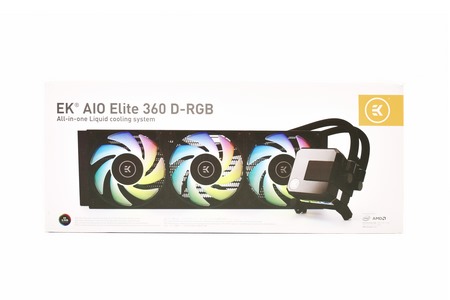

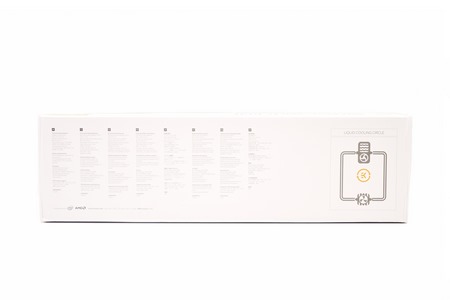














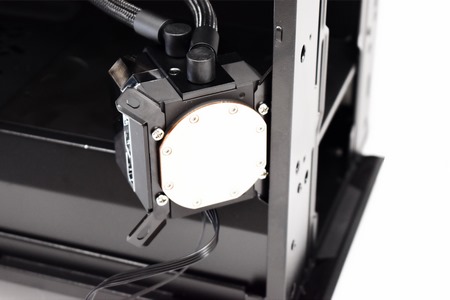









.png)

